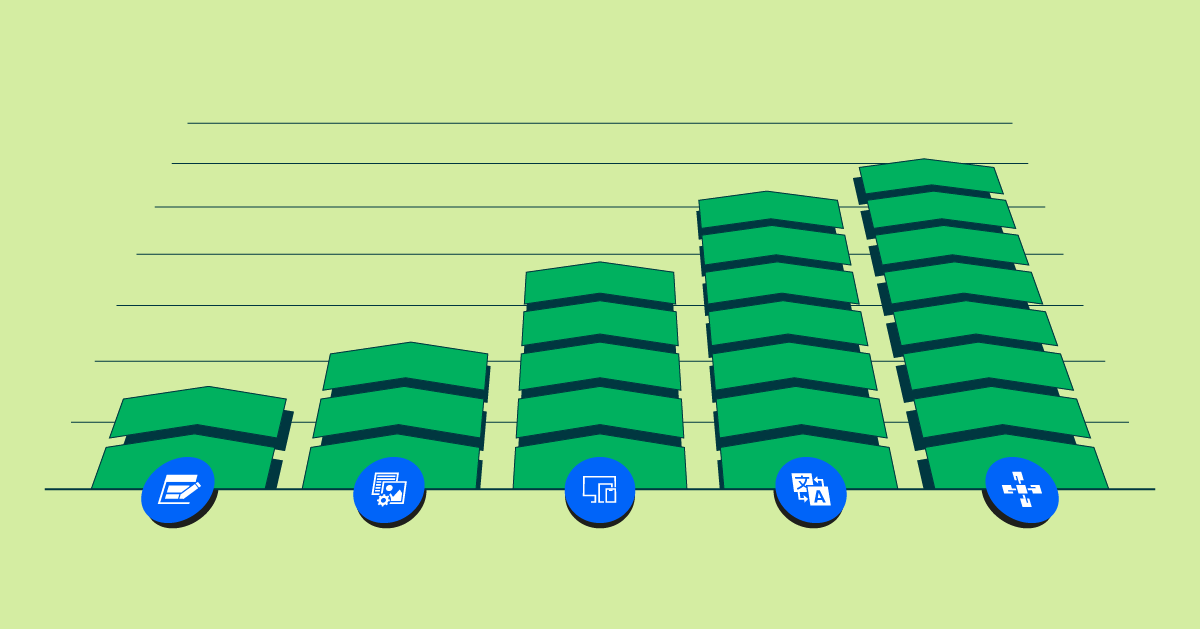- Nov. 28, 2023
- --
Empowering business agility: Key DXP features for dynamic growth
Magnolia in Aktion
Unser Expertenteam zeigt Ihnen live, was Magnolia für Sie leisten kann.
Jetzt Demo buchenThe fact that you’ve got a website or online store doesn’t mean you’re meeting your customers’ expectations for digital experiences. And it could be costing you a lot.
61% of customers will pay more for a good customer experience. A 2020 survey found that unplanned churn due to a bad experience cost brands $35.3 billion.
This was at the start of the pandemic, which raised expectations alongside the number of consumers working and shopping from home. That’s why it’s no surprise that 43% of CIOs prioritize a more agile IT strategy.
One ingredient in those strategies is a digital experience platform (DXP), as it helps you provide a more user-friendly experience within one intuitive user interface. Still on the fence? Read on to learn more.
What is a digital experience platform, and how does it compare to a content management system?
If a CMS gives users a simple editing interface, a DXP focuses on the user, not the content. While it still offers the same content editing capabilities a CMS would, its seamless orchestration of tools and interfaces aims to streamline the entire spectrum of digital experiences for production teams.
DXPs go beyond a CMS by integrating features aimed at crafting immersive experiences tailored to demographics, buying histories, and timely events.
By putting this information at marketers’ fingertips, a DXP enables them to combine data analysis and content management. The constant exchange between the two allows them to improve digital experiences across every channel and be more efficient. And while enjoying a unified user interface for all those tasks is nice, a DXP really shows its true strengths once you look at the collaboration between content marketing, analytics, and sales.
But without a DXP, you’re probably struggling to turn your data into actionable tasks. Think of a DXP as a production engine and mediator that helps different departments bridge the gap between analytics and content planning faster.
Take a composable DXP like Magnolia as an example. Unlike a CMS, Magnolia gives you the same content hub, including marketing assets and design templates, across platforms. This makes it easier to collaborate and maintain editorial standards, no matter if you’re drafting a blog post or a media-rich product description page. Meanwhile, your customers enjoy a consistent experience, from their first ad to the customer newsletter.
By building a user-centric ecosystem, you can spend less time building digital experiences that resonate more with your target audience, leading to more meaningful engagement and better conversions.
Signs you should switch to a composable DXP
Bad customer experiences are rarely the result of unwilling marketers. For the most part, marketing teams are well aware of the benefits of personalized content. They just struggle to deliver them because their solutions aren’t built with the customer, but with production in mind.
Quite often, inflexible architecture and poor integration capabilities force marketers to switch between application windows to copy and paste content. In a setup like this, simply maintaining a basic campaign can be a challenge, let alone a personalized one or anything new.
Here are some warning signs telling you it’s time to make the jump to a composable DXP:
Poor user experience: Frustrated marketing teams rarely build amazing campaigns. If your team is constantly battling technology rather than competitors, then it’s time to find tools that actually let them get the job done.
Inflexible architecture: If you keep struggling to integrate that one marketing tool, chances are it’s time to switch. With a composable DXP, you don’t need to worry about vendor lock-ins or limited scalability.
Security concerns: Routines are great for productivity. But if you’re knowingly ignoring a glaring security gap (maybe using an unsupported monolith DXP version) because “it hasn’t been an issue yet,” then you’re storing up trouble.
If one of your marketing tools keeps you from meeting your compliance objectives, it may save you time or even money now, but you run the risk of paying millions. So it’s best to take those warning signs seriously and tackle them as soon as possible.
DXP 101: From disjointed to seamless customer experiences
The world is moving away from simple content management toward digital experience management. During this transition, the term Digital Experience Platform (DXP) was coined. This white paper will help you make sense of the DXP and equip you with the knowledge you need to choose the right solution for your business.
Features to look for in a DXP solution
Assuming you’re ready to switch to a composable DXP – that still begs the question of which one to choose – it can be difficult to decide on the right tool for the job, especially since not every DXP delivers the same amount of flexibility. Here are a few features to look for:
One streamlined data dashboard: Tracking data is great, but staying on top of the different ways various tools interpret said data can be exhausting. With a tool like Magnolia’s Analytics module, you can easily feed data from various sources into one customizable dashboard.
APIs for an open system: APIs give you the opportunity to embed tools for admin, authoring, or even product management as you see fit. That means you don’t need to worry about compatibility or scalability issues. If you outgrow a tool (or a better alternative emerges), you can simply swap it.
Access controls: Giving everyone access to everything is a recipe for disaster. With fine-tuned access control functionality, you can give team members access to files and modules based on their role, making content easier to manage and ensuring sensitive projects stay that way.
A/B testing and optimization: All the data in the world doesn’t help you if you can’t act on it. Your DXP should let you track A/B testing results over time and optimize landing pages, blog posts, and meta descriptions, even across different versions.
Ecommerce and social media integration: If a DXP doesn’t integrate with your existing platforms, you can’t keep your brand consistent. If every marketing channel relies on the same marketing assets, your customers will soon feel like they know your brand inside out.
Translation and localization: ¿Habla español? Maybe you don’t, but you’re missing out on entire markets if you’re not leveraging localized content. A composable DXP will support you in managing and deploying your translation efforts and customizing content within each local customer segment.
Multi-site, multi-channel, multi-device support: The whole point of a composable DXP is to support you irrespective of your setup, whether you’re running several websites or coordinating campaigns on various operating systems.
How to pick a composable architecture and successfully transition from your CMS
Every business is unique, and so they’ll need to take a slightly different approach to their platform choice, even though a good DXP should accommodate most industry requirements. Still, it’s worth considering your business objectives before making an investment.
For example, a New York business has to meet different privacy requirements than an Italian one, and a young start up has different flexibility or integration needs than an established industry giant.
At this point, it’s worth emphasizing what a composable architecture should look like. Many vendors will promise composability but ultimately mean that you can compose your DXP from their own tools, locking you into their software, thus defeating the whole purpose.
With a truly composable DXP, functionalities are broken down into modular, interchangeable components. Just like with LEGO blocks, this gives you the ability to build a custom system, no matter how specialized your tools are.
Selecting the most suitable composable DXP architecture involves a strategic approach:
Assessment and planning: Evaluate existing content, workflows, and CMS functionalities. Identify what you’d like to retain, modify, or enhance in your DXP solution.
Data migration and integration: Make a plan to identify data that needs to be transferred while ensuring compatibility and maintaining data and system integrity. Similarly, start scoping work to integrate existing business systems that will interact with your DXP that may not have pre-built connectors — e.g. custom or very industry-specific platforms.
Training and adoption: Solid training and support make the difference between a good and a great tool. Take a look at the vendor’s training and support offerings to guarantee a smooth transition.
Testing and optimization: Plan for a thorough testing period to ensure your DXP operates as intended before the first customer interactions. Schedule regular check-ins to fine-tune functionalities based on employee and customer feedback.
Here at Magnolia, we want to give you an idea of what to expect long before you sign up. You can watch our hands-on demo videos to learn about our platform features and have one of our experts walk you through a platform demo. If your developers would really like to dig in, they can even get a 30-day trial so they can start building your personalized project.
During each of these processes, we provide you with different tutorials and support to make sure you get the most out of your time with the platform. If you decide to use our platform, every group within your team will receive tailored training, from admins to developers and authors. That way, everyone has plenty of opportunities to try out new features and see how Magnolia addresses the frustrations we discussed earlier.
Ready to make the switch? Book a demo today!
If you’re trying to maintain a competitive edge in today’s digital marketing landscape, a DXP is the only way to go. It helps you to stay consistent with your marketing efforts while truly leveraging all your data and responding to those insights with personalized digital experiences.
We trust you know your industry best, so we’ll let you be the judge of how Magnolia solves your issues. Give it a try and book a demo today!











